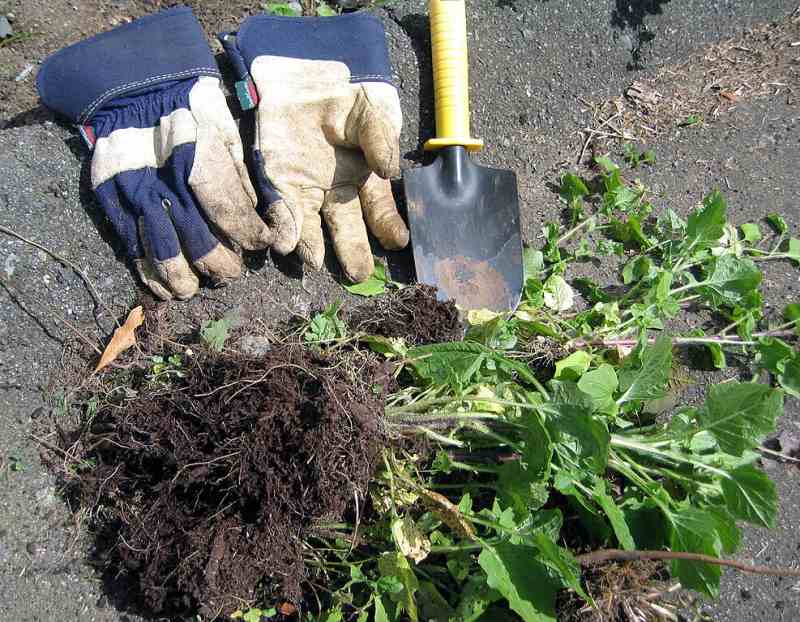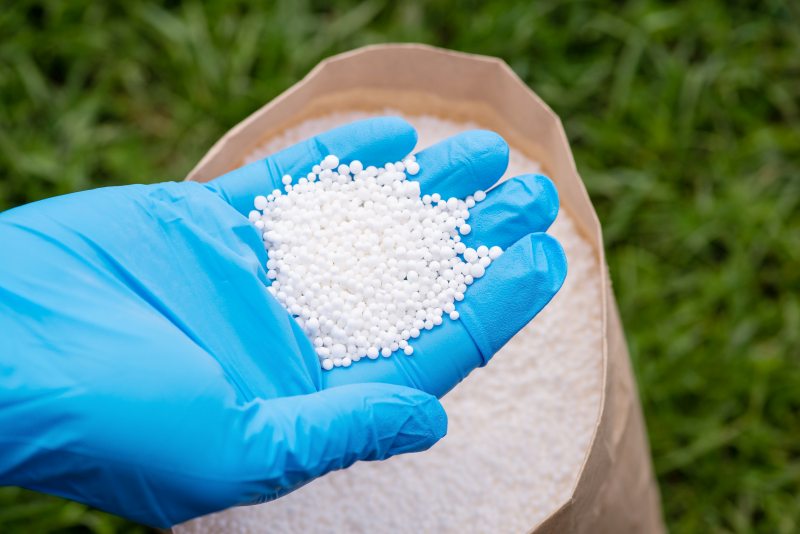
A good lawn care program in Newark includes controlling weeds, diseases, and insect pests. You should also mow regularly, test your soil and fertilize early in the summer and early in the fall.
These things, along with a good mowing approach, proper watering, and occasional aeration, help ensure a dense, green turf. Follow these lawn care tips for Newark and you’ll have thick, green grass when you need it.
Control Weeds

The best way to control weeds is to take good care of your lawn. But weeds can invade even the most pampered lawns.
You can hand-pull weeds as needed. That’s one option. It’s the cheapest way and doesn’t harm the environment or local wildlife with any chemicals. However, if you find that you have a consistent weed problem, use herbicide.
Pre-emergent herbicide will prevent grassy weeds like crabgrass from making their home in your lawn if you apply it before they get a chance to germinate.
If you skip it and find you’re dealing with way too many weeds, post-emergent herbicide can help you get rid of them.
Before you use herbicides:
- Identify the weeds. Here’s a guide to the Most Common Weeds in New Jersey.
- Use the right herbicides.
- Follow the herbicides’ instructions on their labels.
When to use pre-emergent herbicide? The best time to use it is between early- to mid-March.
Dethatch and Aerate

Lawns tend to accumulate organic matter below the grass. This is called thatch. Thatch sized below half an inch is healthy, but anything above an inch is problematic. This is when you need to dethatch. However, a mild thatch problem can be solved with just aeration.
What is aeration, you ask? That’s another job you need to do. Over time, the soil may become compacted. This makes it hard for grass roots to absorb nutrition, water, and air. You should loosen it up annually by aerating. Aeration involves removing parts of the soil and creating small holes. You can aerate after you dethatch, or if your thatch problem is mild, just aerate.
The best time to dethatch and aerate here is in the fall.
Overseed

After you aerate, it’s time to refresh your lawn with new seed. Overseeding plants new seed into existing turf, without tearing or disturbing it. It works great for enhancing your lawn’s color and making it denser. Ensure you pick a grass that matches your current grass.
Overseed within 48 after you aerate for the best results. You can lay a thin layer of compost on your grass before you overseed. Read more about overseeding in this guide.
When should you overseed? Overseed in the fall, after aeration.
Fertilize

Grasses need nutrition just like humans. Your soil may be lacking the nutrients grass needs to flourish. And that’s where fertilization comes in.
The first step is to do a soil test. A soil test will help you find out exactly what is missing in your soil, and how much you need to fertilize, if at all.
You can test your soil at the Rutgers Soil Testing Laboratory. Their test prices range from $20 to $90, depending on which information you want to know. You can also get a DIY soil testing kit, which provide some limited soil information.
When you find out what fertilizer your soil needs, it’s time to apply it. Follow these application guidelines:
| Intensity | Application |
| Low-maintenance | 0 to 2 pounds of N per year per 1000 square feet, applied 0 to 2 times per season |
| Medium-maintenance | 2 to 4 pounds of N per season per 1000 square feet, applied 2 to 3 times per season |
| High-maintenance | 3 to 5 pounds of N per season per 1000 square feet, applied 3 to 6 times per season |
For more, check out When and How Often Should You Fertilize Your Lawn and How to Fertilize Your Lawn.
Prevent and Treat Lawn Diseases

Not to sound like a broken record, but yet again, proper lawn care can do wonders for preventing lawn diseases. Nevertheless, no lawn is immune. If you identify a disease on your Newark lawn, make sure you deal with it immediately. If needed, use a fungicide.
When Common Lawn Diseases Appear in Newark
- Dollar spot: May to October
- Brown patch: June to September
- Leaf spot: Spring and fall
- Red thread: Spring and fall
- Rust: Spring and fall
- Stripe smut: Spring and fall
Mow Correctly

Newark lawns should usually be between 2.5 and 3.5 inches tall. Don’t mow below two inches, or you may damage or weaken your turf. There isn’t a set time you need to start mowing. But because you should never mow more than one-third of your lawn at once, you shouldn’t start mowing before your grass is at least 3.75 inches tall.
You should be able to keep your lawn in good condition by mowing once a week during the growing season. But if you want to keep your grass shorter than 2.5 inches, you may need to mow more often.
Remember to keep sharp blades to not damage your lawn. Additionally, you should leave grass clippings on your lawn after mowing to provide it with nutrition. Use a mulching mower if you want to shred the clippings into smaller pieces.
Check out this article for more mowing tips.
Water Wisely

Generally speaking, grasses need to be watered during the growing season, especially during warm weather and drought. But is this the best practice for Newark?
The rule of thumb is that you need to consistently water new lawns and irrigate during prolonged dry periods. But once they’re established, most Newark grasses usually survive relatively short droughts without supplemental water. This will also result in less fertilizing, and even less mowing, because you’ll be able to keep your grass taller.
Here are the signs that your grass needs water:
- Dull, blue-green color
- Slow growth
- Visible footprints
Make sure to follow Newark’s watering restrictions.
Control Lawn Pests

Once again, the same applies as with weeds: if you take good care of your lawn, you’re less likely to deal with pests. But your lawn won’t ever be invincible to them.
If your lawn has insect pest issues, you may need to use a pesticide. Depending on the pest, you can also take other measures to remove them from your lawn.
Here are some of Newark’s most notorious pests and how to get rid of them:
- Grubs: Take good care of your lawn. Grubs have natural predators like ground beetles. If needed, use a pesticide to treat a grub infestation. It’s easiest to use a curative chemical treatment while the grubs are still small from August to September. You can also use a preventative pesticide. Depending on which chemical and which grub type you deal with, you may be able to use a preventative pesticide between May and July.
- Sod webworms: Sample or inspect your lawn before you treat sod webworms. They’re relatively easy to control as needed. These pests have natural predators like ants, ground beetles, and many bird species. There’s a number of chemical products you can use to manage a sod webworm problem, too. The best time to apply chemical treatments is in the late afternoon or in the evening. Rotate different chemical treatments to minimize the chances of resistance.
- Hairy chinch bugs: These are some of the most dangerous lawn pests in Newark. Sometimes, their nymphs drown in spring rains. Nevertheless, be sure to monitor your lawn to detect an infestation early. Use a preventative or a curative pesticide as and if needed.
FAQ
What are the best grasses for Newark?
Most Newark lawns grow cool-season grasses like Kentucky bluegrass, tall fescue, fine fescue, and perennial ryegrass. You can read all about them in our article Best Grass Seed for New Jersey.
Should I leave grass clippings on my lawn?
Yes; leave grass clippings on your lawn after each mow for a quick and easy “grass snack.” Read about their benefits in our article Reasons to Use Grass Clippings as Mulch.
How do I sharpen my mowing blade?
One of the ways of sharpening your mowing blade is by using a metal hand file to sharpen your mowing blade. Check out a step-by-step guide on our website.
Hire a Pro
Always be careful when using chemical products. Try to avoid them altogether when you can. They pose a potential hazard to the environment, local wildlife, and your pets. Always read your instruction labels.
The best cure for lawn problems is prevention. Prevent your lawn from withering down by taking great care of it. You’ll be glad to know that you don’t need to spend hours researching how to take care of your yard. Instead, call a LawnStarter pro.
Main Photo Credit: King of Hearts / Wikimedia Commons / CC BY-SA 4.0